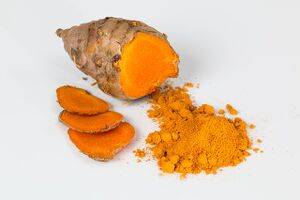How to Process Turmeric: Unterschied zwischen den Versionen
K (Schützte „How to Process Turmeric“ ([Bearbeiten=Nur automatisch bestätigten Benutzern erlauben] (unbeschränkt) [Verschieben=Nur automatisch bestätigten Benutzern erlauben] (unbeschränkt))) |
|||
| Zeile 1: | Zeile 1: | ||
| + | [[Datei:Turmeric-3251560 640.jpg|mini|rechts]] | ||
==Übersicht== | ==Übersicht== | ||
[[Howtopedia | Übersicht übernommener Howtopedia Artikel]], [[Wie man einen effizienten Holzofen baut | Zum Übersetzten Artikel]] , [[How to Process Turmeric | zum originale Artikel]] | [[Howtopedia | Übersicht übernommener Howtopedia Artikel]], [[Wie man einen effizienten Holzofen baut | Zum Übersetzten Artikel]] , [[How to Process Turmeric | zum originale Artikel]] | ||
Version vom 3. Juni 2021, 15:18 Uhr
Inhaltsverzeichnis
Übersicht
Übersicht übernommener Howtopedia Artikel, Zum Übersetzten Artikel , zum originale Artikel
Processing of Turmeric - Technical Brief
|
Turmeric (Curaima Domestua) |
Agricultural and botanical aspects
Turmeric is an erect perennial plant grown as an annual. It requires a loamy soil and is propagated vegetatively.
Harvesting
The whole plant is removed from the ground. Care needs to be taken to prevent the rhizomes being cut or bruised.
Sweating
The leaves are cut off and the roots washed carefully in water. The lateral branches of the rhizomes ("fingers") are cut off from the central "bulb" ("mother"). The "fingers and "mothers" are heaped separately, covered in leaves to sweat for a day.
Boiling
The rhizomes need to be boiled or steamed to remove the raw odour, reduce the drying time, gelatinise the starch and produce a more uniformly coloured product.
Traditionally in India the rhizomes were placed in pans or earthenware pots filled with water and covered with leaves with cow dung over the top. The ammonia in the cow dung reacted with the turmeric to produce the final product. For hygienic reasons this method is being discouraged.
The present practices recommended are:
- The rhizomes are placed in shallow pans in large iron vats.
- Water is added to a level at 5-7cm above the rhizomes.
- Add 0.05 - 0.1% alkali (eg sodium bicarbonate).
- The rhizomes should be boiled for between forty to forty-five minutes (as is done in India) and six hours (as is done in Hazare in Pakistan) depending on the variety.
Drying
The rhizomes are removed and dried in the sun immediately to prevent over cooking. The final moisture content should be between 8 and 10% (wet basis). When a finger will snap cleanly with a metallic sound it is sufficiently dry.
Polishing
The dried rhizomes are polished to remove the rough surface. This can be done by hand or by shaking the rhizomes in a gunny bag filled with stones. Polishing drums are in use in many places. These are very simple power driven drums.
Adulteration
Lead chromate is sometimes used to produce a better finish. This should be actively discouraged.
Varieties of turmeric
Allepey
This is from Kerela and is a deep yellow colour with a high pigment content (6.5% curcumin level). This is popular in the USA.
Madras
This is from Tamil Nadu and is a mustard colour with a lower pigment content (3.5% curcumin level). This is popular in the UK.
West Indian
This is from the Caribbean and is a dull yellowish brown.
Standards
US Government Standards and the American Spice Trade Association Standards
|
Moisture content % |
<9 |
|
Curcumin % |
5-6.6 |
|
Extraneous matter % (by weight) |
<0.5 |
|
Mould % |
<3 |
|
Volatile oil ml/100g |
<3.5 |
Reference and further reading
Drying Technology, Practical Action Technical Brief
Spice, Practical Action Technical Brief
Cardamom, Practical Action Technical Brief
Cinnamon, Practical Action Technical Brief
Cumin, Practical Action Technical Brief
Nutmeg and Mace, Practical Action Technical Brief
This Howtopedia entry was derived from the Practical Action Technical Brief Energy from the Wind.
To look at the original document follow this link: http://www.practicalaction.org/?id=technical_briefs_food_processing
Useful addresses
Practical Action
The Schumacher Centre for Technology & Development, Bourton on Dunsmore, RUGBY, CV23 9QZ, United Kingdom.
Tel.: +44 (0) 1926 634400, Fax: +44 (0) 1926 634401
e-mail:practicalaction@practicalaction.org.uk
web:www.practicalaction.org

Related Articles
- How to Preserve Food with Small Scale Drying Technologies
- How to Preserve Food by Drying
- How to Use Sun Power
- How to Make Chocolate
- How to Preserve Tomato
- How to Preserve Food with a Solar Dryer
- How to Process Spice
- How to Process Turmeric
- How to Build a Tray Dryer
- The Anagi Tray Dryer
- How to Dry Chillies
- How to Process Pepper
